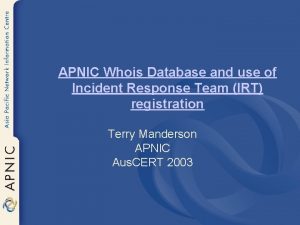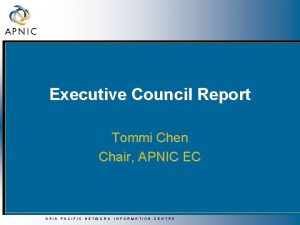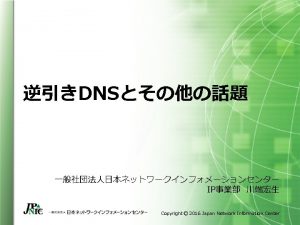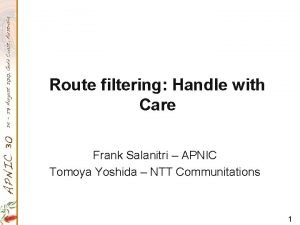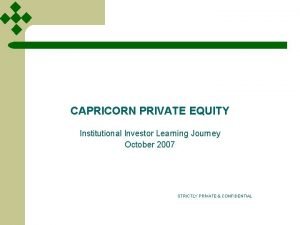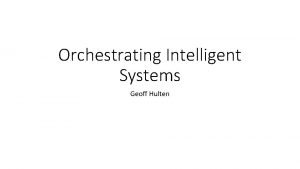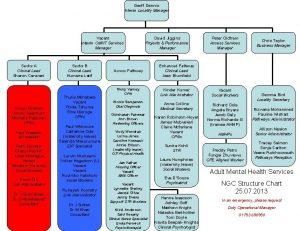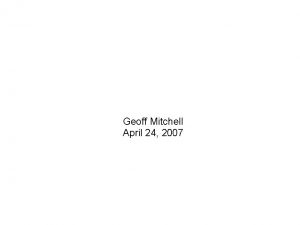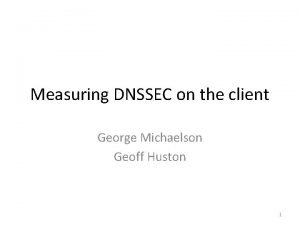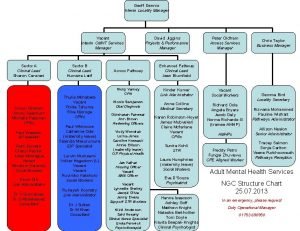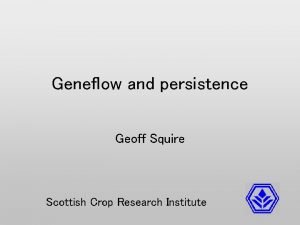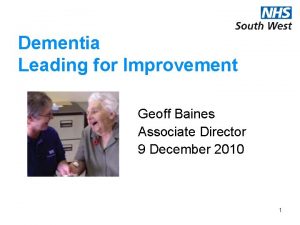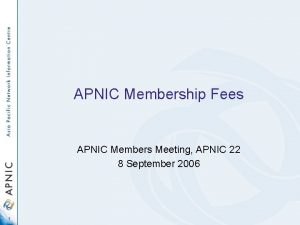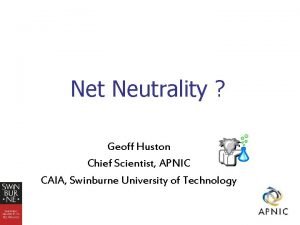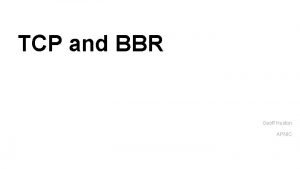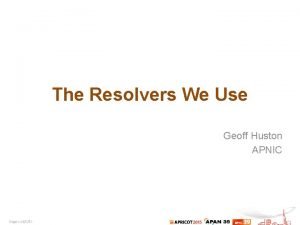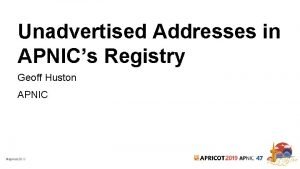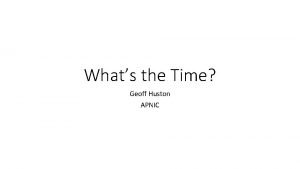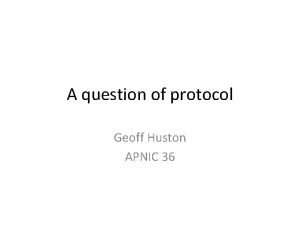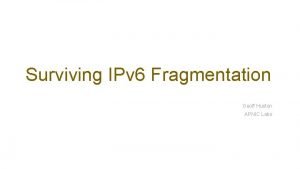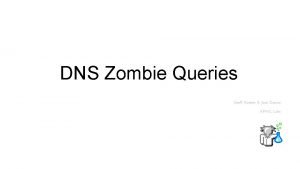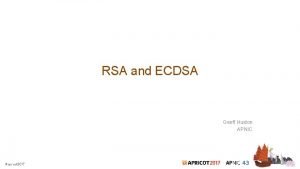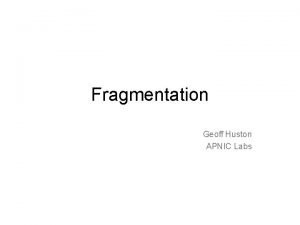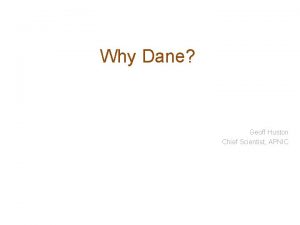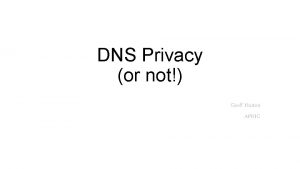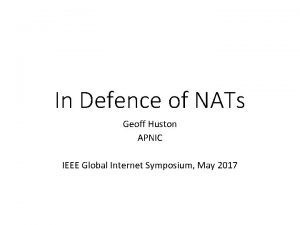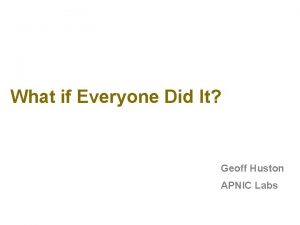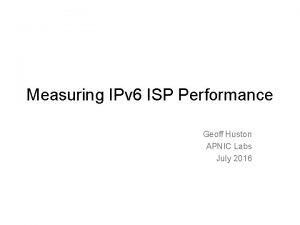Desperately Seeking Default Geoff Huston APNIC In the
























































- Slides: 56

Desperately Seeking Default Geoff Huston APNIC

In the Telephone Network • All telephones were equally reachable • Anyone could dial anyone else

Internet In the Telephone Network • Are all connected endpoints equally reachable? • • Can anyone can reach anyone else?

Internet In the Telephone Network • Are all connected endpoints are equally reachable? • Can anyone can reach anyone else? No!

Internet In the Telephone Network • Are all connected endpoints are equally reachable? • Can anyone can reach anyone else? No! e Internet th f o n o ti p our conce d e g n er a h c client/serv ll Filters d a e w it e m ir li F a d k to NATs an er networ e p to r e e from a p c service. li e r b u tu p c e a it p h du arc aybe if you stan t a th T, then m e r A a N s a n f o o ti ide nt expecta atter) outs o. m t a Our curre th r e, n (or 443 fo t otherwis u b , u on port 80 o y can reach everyone

Internet In the Telephone Network • All connected endpoints are equally reachable • Can anyone can reach anyone else?

Internet In the Telephone Network • All connected endpoints are equally reachable • Can anyone can reach anyone else? is, but th K IN H T t h ig We m ALL the time? is it true

What do we see? On the Internet is everyone really connected to everyone else?

How We See We use an online ad to present a sequence of small fetches to the user’s browser

How We See The sequence of tests is used to test a number of types of actions including fetches of IPv 4, IPv 6 and Dual stack

How We See We use tcpdump to record all packet activity at the experiment’s servers

What we see: Connection Failure Outbound SYN client server Busted SYN ACK Return path is an s e se g rver matchin e s t the t no ACK Wha YN, bu coming in ing S m o nc i

Daily IPv 6 Failures 6 to 4 failure: around 10% Average IPv 6 failure: around 2% Unicast IPv 6 failure: around 1. 5%

Daily IPv 6 Unicast Address Failures 1. 5% failure rate

IPv 6 Failures • 1. 5% failure for unicast V 6 is unacceptable! • Why is this happening – Auto-tunnelling? – Lousy CPE firmware? – Strange firewall filters? • But is all of this due to local configuration / equipment? • What is the comparable view in IPv 4?

IPv 4 Connection Failure 0. 2% failure rate

IPv 4 Failures • IPv 4 failures are around 1 in 500 • And we are pretty sure its NOT: – Auto-tunnelling – Lousy CPE firmware – Strange firewall filters • So what is the reason for this residual asymmetric failure rate? • Is it asymmetric routing connectivity?

Route Views Routing Table

25 Years of Routing the Internet This is a compound view pulled together from each of the IPv 4 routing peers of Route Views and RIS

IPv 4 - 2015/16 IPv 4 Route Views + RIS This is a view pulled together from each of the routing peers of Route Views and RIS That’s a range of 100, 000 routes!

Different peers see a slightly different Internet • But is this just traffic engineering more specifics? • Or do different peers see a different set of reachable addresses in the routing table?

Address Span (Route Views + RIS data sets)

Address Span (Route Views + RIS data sets) 15 M Addresses

What does this mean? • Each peer of Route. Views and RIS announces a span of addresses that appears to be a unique span. • In total, these spans agree with other to within ~20 M addresses, but this means that there are potentially some 20 M uniquely addressed endpoints that cannot be reached from all other endpoints. • This variation is stable over time for each peer, so its not transient routing that is generating this – the reasons for this difference in reachability are structural

What about IPv 6?

The Route Views view of IPv 6 World IPv 6 Day IANA IPv 4 Exhaustion

Number of IPv 6 Routes in 2015/16 That’s a range of 2, 300 routes!

IPv 6 Announced Address Span Variation (RV + RIS)

IPv 6 Announced Address Span Variation (RV + RIS)

What is “default”? We don’t know! There is no “default” route set that we can all agree on

What is “default”? • At best “default” is an informal quorum – So lets define this quorum by arbitrarily setting the quorum threshold at 2/3 – i. e. if 2/3 of the peers of a route collector advertise a route then it is part of the default quorum. • Individual peer networks will contain route sets that differ from this quorum by having both additional prefixes and holes. – Lets look at the variance from the quorum

A “Quorum” deviation view of IPv 4

A magnified view

IPv 6 “Quorum” Deviation

Zooming In

And Again

Quorum Deviation for RVA IPv 4 Peers (18 th August 2016)

Quorum Deviation for RIS IPv 4 Peers

Quorum Deviation: IPv 6, RVA

Quorum Deviation: IPv 6, RIS

It’s structural, not temporal • There is a visible stability to this deviation from the quorum route set – The variation from the quorum is long–term stable, and does not rapidly selfcorrect – its not a transient routing state • We appear to assume that all Tier 1 providers, and their Tier 2, 3, … resellers offer the same reachability set as each other – i. e. ”default” is consistent everywhere • But this is not necessarily the case all the time for every address in the routing system • “Default” appears to vary by provider and by location – E. g. : 25 April, 1600 UTC: AS 2914: Route. Views 2, 808, 560, 896 addresses RIS: 2, 807, 358, 208

”Default” is a market outcome • There is no ”global route arbiter” • There is no way to enrol a route into a global Internet default route set • There is no single common definition of “default” • Instead ”default” is a market outcome – You buy default from a transit • You hope your transit is offering you what it promised – but you just can’t tell – You add your route to default via a transit • You hope that this will propagate reachability tp your network to all parts of the Internet – but you just can’t tell

So What? Surely all this is patched up by the widespread use of a routing default entry in addition to specific routes? (*) * Internet Optometry: Assessing the Broken Glasses in Internet Reachability”, R. Bush, O. Maennel, M. Roughan, S Uhlig, ACM SIGCOMM IMC, 2009

So What? Surely all this is patched up by the widespread use of a routing default entry in addition to specific routes? – Well, not really – Default points along upstream transits – It does not patch downstreams Route to B not propagated on this connection Packet from B to A follows explicit route A Packet from B to A follows default and then dropped B

To Recap: What is causing this?

To Recap: What is causing this? Could part of this be due to connectivity failure?

Can we confirm this? Outbound SYN client server

Can we confirm this? Outbound SYN client server SYN ACK Return path

Can we confirm this? Outbound SYN client router Busted SYN ACK Return path server

Can we confirm this? Outbound SYN client server router Busted SYN ACK Return path ICMP Dest Unreachable

Can we confirm this? Outbound SYN client server router Busted SYN ACK Return path ICMP Dest Unreachable is an s e e P rs erve n an ICM le s e t th he ab Wha N, and t unreach g SY tination n i m des inco

And we do see this … here’s an example 14: 16: 05. 999497 IP (tos 0 x 0, ttl 55, id 31005, offset 0, flags [none], proto ICMP (1), length 80) 84. 41. 108. 74 > 139. 162. 146. 97: ICMP host 46. 163. 47 unreachable, length 60 Outer packet is an ICMP Packet with a “destination unreachable” code sent to the server from the router at address 84. 41. 108. 74

And we do see this … here’s an example 14: 16: 05. 999497 IP (tos 0 x 0, ttl 55, id 31005, offset 0, flags [none], proto ICMP (1), length 80) 84. 41. 108. 74 > 139. 162. 146. 97: ICMP host 46. 163. 47 unreachable, length 60 Outer packet is an ICMP Packet with a “destination unreachable” code sent to the server from the router at address 84. 41. 108. 74 IP (tos 0 x 0, ttl 57, id 0, offset 0, flags [DF], proto TCP (6), length 52) 139. 162. 146. 97. 443 > 46. 163. xx. 52087: Flags [S. ], cksum 0 x 5130 (correct), seq 3917125220, ack 685287936, win 29200, options [mss 1460, nop, sack. OK, nop, wscale 7], length 0 Payload packet is a SYN+ACK packet

Internet In the Telephone Network • All connected endpoints are equally reachable • Anyone can reach anyone else Almost almost of the time!

Internet In the Telephone Network • All connected endpoints are equally reachable • Anyone can reach anyone else Almost almost of the time! ct to s can conne rk o tw e n s s e eder acc en nobody fe th , … ll n a o z s a a m y, A As long d to fix this , Netflix, Eba te le a g v o ti o o G m , k e o b to Facebo ugh any more o n e re a c to seems er system. d e fe N D C 1 tier cted in 2016 is a e v a h s fully conne w u o o n it e u w iq t n a u h e W a tru t is is no longer tor about tha t c e fa rn re te a in c e e h v T ecti , and our coll rk o tw e n r e e p pretty low~ s me sad! ke And that ma

Thanks!
 Geoff huston apnic
Geoff huston apnic Pure fabrication design pattern
Pure fabrication design pattern Langston huston
Langston huston The heart is wicked
The heart is wicked Apnic whois
Apnic whois My.apnic
My.apnic Apnic ec
Apnic ec Apnic dns
Apnic dns Animal anthony apnic
Animal anthony apnic Debogon project
Debogon project Geoff barton headteacher
Geoff barton headteacher Geoff buckley
Geoff buckley Geoff kleinman
Geoff kleinman Capricorn private equity
Capricorn private equity Geoff hulten
Geoff hulten Geoff savage
Geoff savage Kavita deepak knights
Kavita deepak knights Geoff mason
Geoff mason Conclusion of the skin
Conclusion of the skin La noche boca arriba summary
La noche boca arriba summary Sue cowley behaviour management
Sue cowley behaviour management Geoff wilson lexington ky
Geoff wilson lexington ky Geoff hollington
Geoff hollington Geoff petty
Geoff petty Geoff mitchell md
Geoff mitchell md Cdmhp
Cdmhp Geoff parks
Geoff parks Watchdog dad
Watchdog dad Geoff michaelson
Geoff michaelson Geoff hayward
Geoff hayward Lurvin munisami
Lurvin munisami Geoff squire
Geoff squire Geoff barton dundee
Geoff barton dundee Geoff cundiff
Geoff cundiff Geoff knowles
Geoff knowles Geoff layer
Geoff layer Thinking skills and personal capabilities
Thinking skills and personal capabilities Geoff willis
Geoff willis Geoff goldsmith
Geoff goldsmith Geoff baines
Geoff baines Các châu lục và đại dương trên thế giới
Các châu lục và đại dương trên thế giới Từ ngữ thể hiện lòng nhân hậu
Từ ngữ thể hiện lòng nhân hậu Diễn thế sinh thái là
Diễn thế sinh thái là Thứ tự các dấu thăng giáng ở hóa biểu
Thứ tự các dấu thăng giáng ở hóa biểu Phép trừ bù
Phép trừ bù Hát lên người ơi alleluia
Hát lên người ơi alleluia Tỉ lệ cơ thể trẻ em
Tỉ lệ cơ thể trẻ em Lời thề hippocrates
Lời thề hippocrates Khi nào hổ con có thể sống độc lập
Khi nào hổ con có thể sống độc lập đại từ thay thế
đại từ thay thế Vẽ hình chiếu vuông góc của vật thể sau
Vẽ hình chiếu vuông góc của vật thể sau Quá trình desamine hóa có thể tạo ra
Quá trình desamine hóa có thể tạo ra Công của trọng lực
Công của trọng lực Thế nào là mạng điện lắp đặt kiểu nổi
Thế nào là mạng điện lắp đặt kiểu nổi Hình ảnh bộ gõ cơ thể búng tay
Hình ảnh bộ gõ cơ thể búng tay Dạng đột biến một nhiễm là
Dạng đột biến một nhiễm là Vẽ hình chiếu đứng bằng cạnh của vật thể
Vẽ hình chiếu đứng bằng cạnh của vật thể




